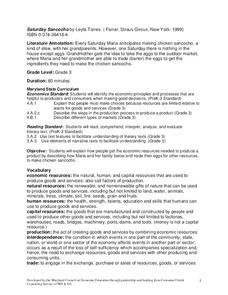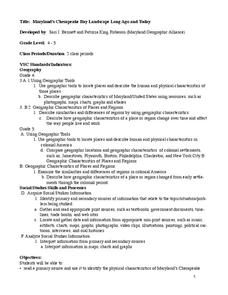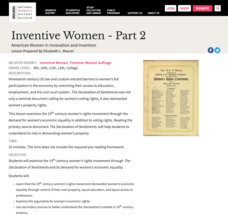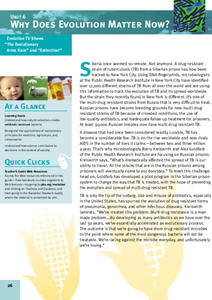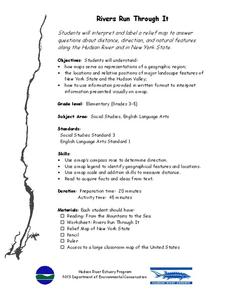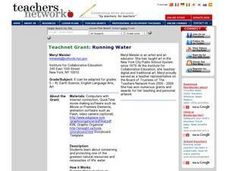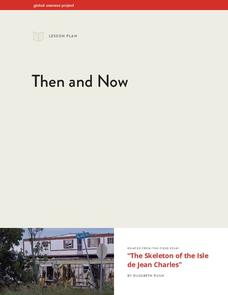Global Oneness Project
Learning with Nature
Think outside the box - and think about education beyond the classroom walls - with a resource that has your critical thinkers watching a video about a nursery in Scotland that lets youngsters roam wild in a forest....
Curated OER
Understanding the 1855 Census Database
Use data from the 1855 New York census to better understand the Irish immigrant experience during the late 19th century. Young historians analyze information from the census and build three hypotheses regarding the residents of the Five...
Curated OER
Massive Tornado in Missouri
The New York Times published an article on the tornado that hit Joplin, Missouri in 2011. Learners read the article then answer each of the 11 who, what, when, where, and why questions. Hint: This article and ones like it link to a...
Curated OER
Saturday Sancocho
Second graders identify the economic principles and processes that are helpful to producers and consumers when making good decisions. Students will read, comprehend, interpret, analyze, and evaluate literary text as well as explain how...
Global Oneness Project
Ancient and Modern Worlds
The old aphorism, "The road to Hell is paved with good intentions," might well serve as the title for a resource that asks viewers to consider the plight of the people of the Gamo Highlands, an area in southwestern Ethiopia. These...
Curated OER
Maryland’s Chesapeake Bay Landscape Long Ago and Today
Combine a fantastic review of primary source analysis with a study of Captain John Smith's influence on the Chesapeake Bay region in the seventeenth century. Your young historians will use images, a primary source excerpt, and maps...
National Woman's History Museum
Inventive Women - Part 2
The Declaration of Independence was published in 1776. The Declaration of Sentiments and Resolutions, modeled after the Declaration of Independence, was drafted and read by Elizabeth Cady Stanton at the Seneca Falls Convention in 1848....
The New York Times
Investigating the Heroin and Prescription Opioid Epidemic
How bad is the opioid crisis in America? Has it gotten worse in the last few decades? Why? High schoolers delve into these questions with a thorough and thoughtful lesson from The New York Times on heroin prescription opioids....
Curated OER
Nature in a Flick of the Eye
Students explore the visual information a diorama artist provides by thinking of all the details for the background of a location described by their teacher. They investigate diorama artists and their importance in creating the illusion...
Curated OER
A Disaster in the Making
Students compare the consequences of the 1906 earthquake in San Francisco to Hurricane Katrina's impact on New Orleans as a basis for investigating the transformative effect of infamous United States natural disasters.
Curated OER
Feeling Vulnerable
Students discover some of the ways the developing world is vulnerable to the impact and effects of natural disasters. They investigate some "natural disaster hotspots" around the globe and assess how vulnerable these areas are.
Curated OER
The Wrath of Hurricane Mitch
Students investigate how hurricanes and other natural disasters can devastate the elements of the infrastructure of a country, as well as the lives of its people.
Curated OER
Why Does Evolution Matter Now?
Young scholars examine how natural selection creates antibiotic-resistant bacteria,
recognize applications of evolutionary principles for medicine, agriculture, and conservation, and discuss how science contributes to decisions in...
Curated OER
Disaster Talk
Students design new devices to help victims of natural disaster communicate with rescue workers, government, media and loved ones. For homework, they write proposals promoting their technology.
Curated OER
Economic Use of Public Natural Areas
Students examine the public controversy between the use of public natural areas for economic activities by viewing video clips, researching on the Internet, and calculating sustainable land.
Curated OER
Rivers Run Through It
Using a relief map of New York State, learners answer questions about the distance between different cities, identify bodies of water, and more. First, they discuss vocabulary related to the Hudson River area. Then, they complete a...
Curated OER
Running Water
Sixth graders create products that feature the importance of water conservation. In this environmental stewardship lesson, 6th graders explore the water cycle and conduct on water usage. Students also research water pollution and...
US Institute of Peace
Defining Conflict
Conflict is everywhere—but is it avoidable? The first activity in a series of 15 peacebuilding lessons examines the nature of conflict at home, school, and across the world. Learners develop a definition of conflict through group work...
Curated OER
Stranger Than Fiction
Students reflect on the importance of science literacy. They review the year's science curriculum by reading, discussing and writing questions on teacher-selected New York Times articles and the related science content.
Curated OER
On the Fence
Students read a news article from the New York Times related to the construction of a fence between Mexico and the U.S. and its impact on the lives of the people living on both sides. They read and discuss a variety of scenarios, answer...
Curated OER
The Hunter Using Children's Literature to Teach the Geography of Africa
Students are able to answer basic questions about the region and the use of natural resources, sketch a mental map of the story's setting, and find their way through the thematic maze/map.
Curated OER
Warning Signs for Dangerous Times
Students explore the use of storm-tracking technologies, research and present how they forecast natural disasters, and assess the importance of these technologies.
Curated OER
When Disaster Strikes
Students examine the ways major industries are affected by and respond to natural disaster. They interview local representatives of these industries on how they prepare for and manage such disasters.
Global Oneness Project
Then and Now
The devastating changes happening to the Native American inhabitants of an island off the coast of Louisiana are the topic of an informational lesson. After scholars break into groups to explore particular topics, they come back together...



